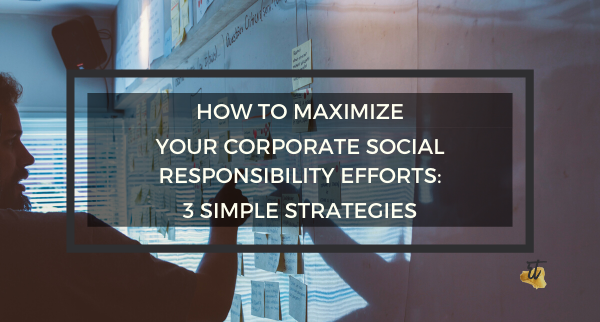It’s no secret that Corporate Social Responsibility is now not only a greater part of the conversation when it comes to consumerism but, it has also become a foundational aspect within business models. With that being said, I’m always so shocked to see how many businesses carry some type of corporate citizenship within their company model but the only place you’re ever really going to hear about it is through some peer journal or by landing on their website after some research.
Really? Is that how you want to communicate your social and environmental impacts to your greatest shareholder, your consumer?
I feel many companies have missed the mark on not only how to communicate their Corporate Social Responsibility but also, have missed a HUGE opportunity to stand out amongst their peers, and most importantly, their consumers. So, today, I’m going to give you 3 simple strategies on how to maximize your Corporate Social Responsibility efforts.
- Be Loud and Proud
Seriously? A page or two on your website under “Social and Environmental Accountability” or “Corporate Responsibility”? I know, you companies, know better than that!
Today, your buyers aren’t coming to your website first, instead, they’re on your social. They’re hitting up your Instagram or Facebook accounts. They’re visual purchasers, they want to know more details and that doesn’t start at your website. So, when you put the most important aspect of your business model on a webpage where you have to dig to find it in the first place, you’re not really capturing the market that cares about social and environmental accountability.
The consumers of 2020 are Gen Xers, Millennials, and Gen Zs. These guys are powered to purchase through corporate citizenship. So, why are you leaving that on the table?
Post about it on your most powerful platforms! Don’t just post the latest sale or the coolest thing, instead, post about the newest initiative your company is working on. Take an opportunity to put your brand in the spotlight, capitalizing on your consumer’s values through Conscious Business.
- Make It Obvious
I feel like I need to throw down another seriously?!When your consumer does land on your website, yes, for sure you want them to head to the inventory but, that’s not always the case, is it? If you’ve got a newer visitor, that consumer is going to do their research first especially if it’s one of the 3 main demographics of 2020 consumers.
Instead of having them type into Google to find out if your company is a Corporate Citizen, why not display it in your navigation bar on your website? Make it obvious! Let them see your commitment to social and environmental accountability is just as important to you, as a brand, as your product is. Consumers want to know the brand stands for something way more! When you create this seemingly simple and small change, you connect with the buyer’s emotions. They are more apt to purchase from you knowing you’re a responsible company.
- Don’t Ignore Your Most Important Stakeholders
Often when we think of stakeholders in a company we think about the board members, the C-Suite, investors, government agencies, suppliers, employees, unions and more. The point? Companies tend to focus more on their internal and some external stakeholders, in my opinion, and often miss out on the huge opportunity with their biggest stakeholder: customers.
When building strategies, gathering data, setting KPIs and building reports for impact management, companies often leave out the consumer. Not on purpose but rather it’s an oversight, in my opinion. You’re already paying attention to what your consumer is looking for. You keep your hand on the pulse for the latest trends to satisfy their needs, so, why not ask them what they want to see in terms of social and environmental accountability from you as a brand?
Opening up communication with the biggest stakeholder you have is a huge opportunity to create innovative strategies but also, to show your community they mean more than just a purchase. They are a part of your brand aside from a label. They are a part of a movement. They are a part of something bigger.
That’s the connecting piece that’ll have consumers talking up a storm, giving you ideas, feedback, and, most importantly, catching the attention of others who would have otherwise gone to your competitor.
Although these 3 strategies don’t seem like groundbreakers, if implemented correctly, they can have a huge impact on your sustainability efforts and, most importantly, on your bottom line.
When thinking about sustainability strategies, more often than not, taking a step back and starting small is the biggest way to create an impact. I suggest you do a quick audit of your own business in relation to the 3 strategies mentioned above. Once you’ve determined where you stand, pick 1 of the above-mentioned strategies you’re going to work on for the next 30 days and do it!

